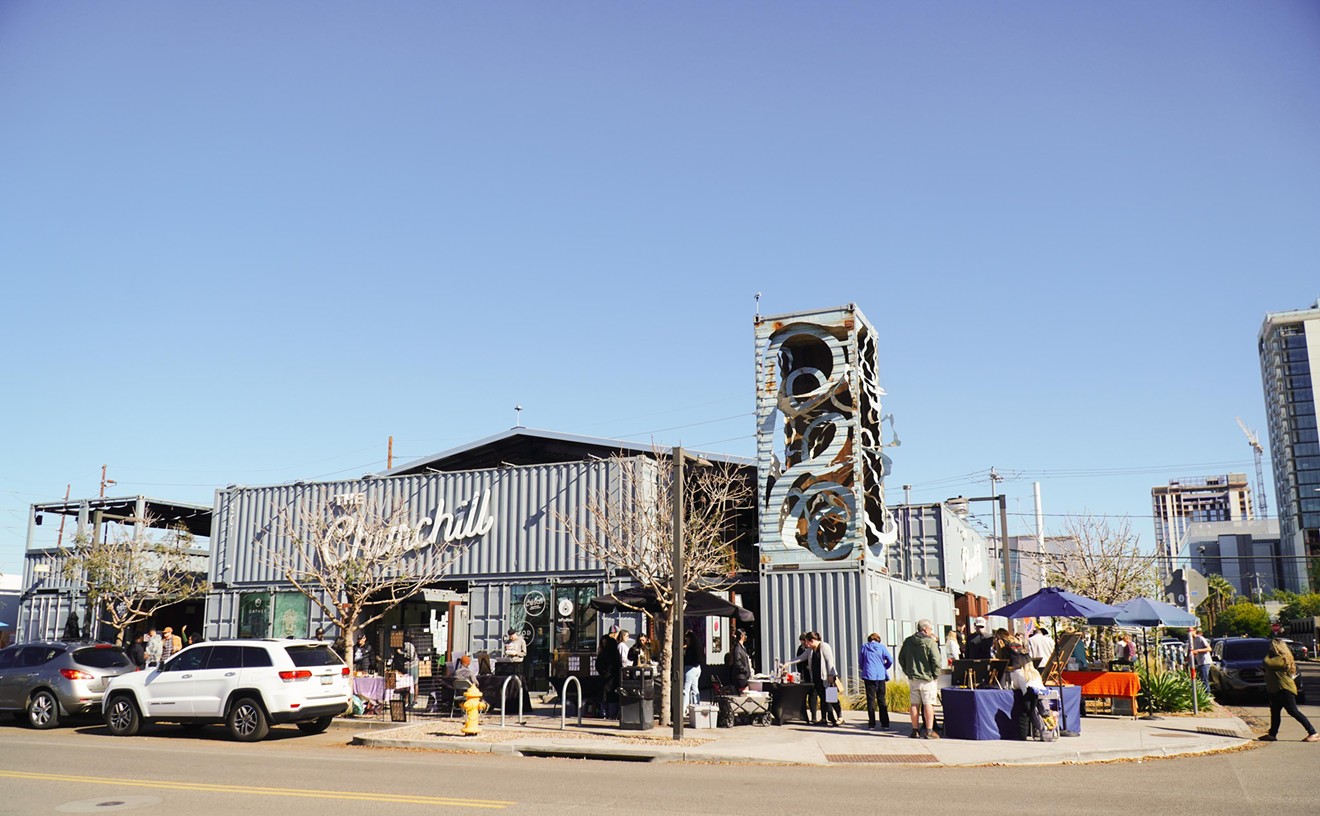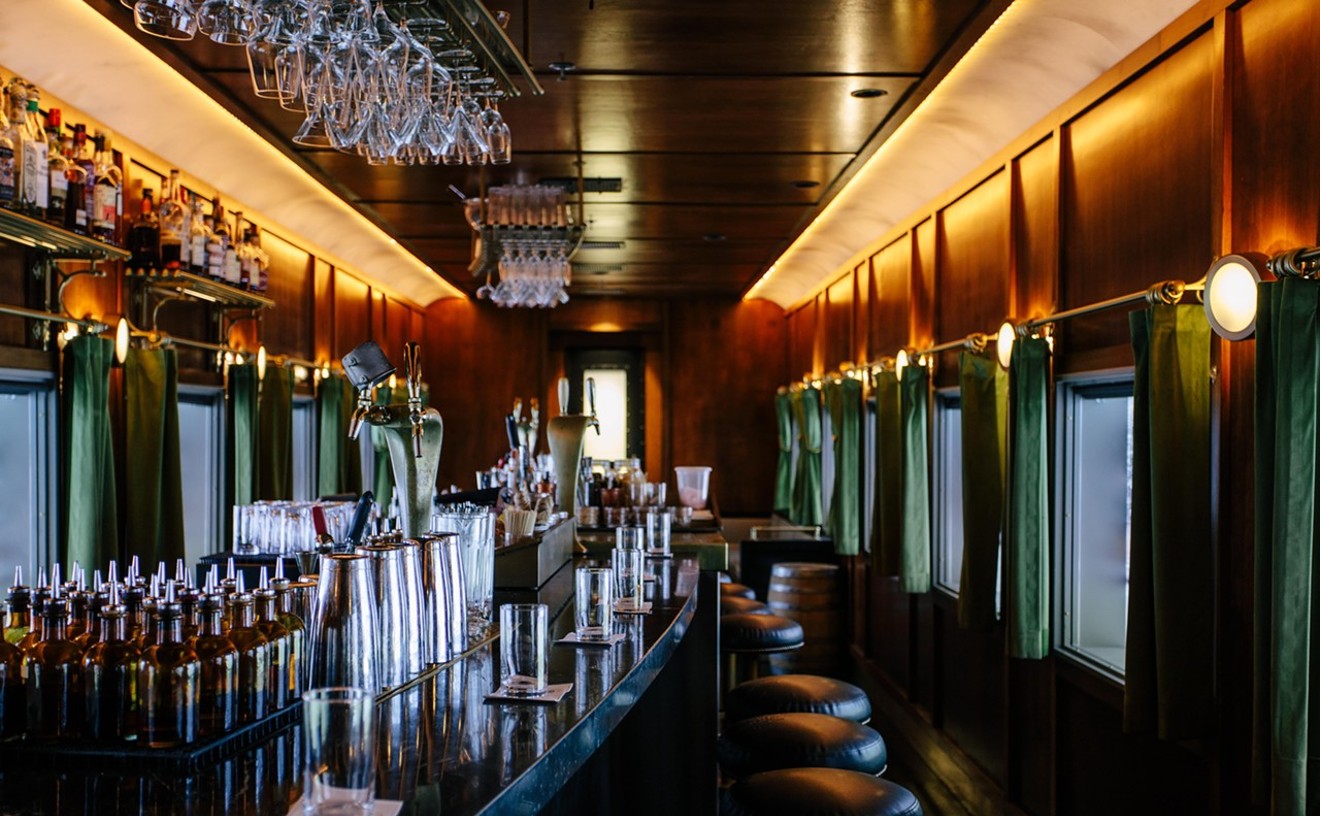Summer is busting out all over. And in Tempe, Japanese restaurants are sprouting up like mung beans! In the last few months, two new restaurant-sushi bars have opened within mere blocks of each other. And, while both offer fine Japanese dining, neither is truly authentic--or truly wonderful.
In the case of Ichiban, it takes me two visits to figure this out.
Ichiban is located in what used to be Arizona Beach Restaurant on University Drive across from the Arizona Public Service Company power plant. Initially, I like the new interior. Ichiban's owners have corrected many of the problems that troubled Arizona Beach Restaurant, (which, though it doesn't sound like it, was also a sushi bar). The location's nasty Western exposure has been dealt with by covering the windows with Japanese paper screens and cranking up the AC. The high ceiling near the entrance has been decorated to advantage with boughs of silk cherry blossoms and pine branches. The decor as a whole looks more integrated.
Yes, it takes a while to break it all down, but on my second visit, I begin to figure out just what the problem is. Put quite simply, Ichiban's owners didn't know when to stop. Every space, every surface in the restaurant is decorated with some kind of adornment. The resulting clutter is diametrically opposed to the stark elegance of basic Japanese design. A bud vase of silk roses on each table? Come on. This is a dead giveaway that something is wrong with this picture.
But even if you were to overlook these visual clues, Ichiban's menu might strike you as slightly odd for a "traditional Japanese restaurant." Why, for instance, does it include bul go ki (barbecued beef) and gal be (barbecued beef ribs)? These are Korean specialties, not Japanese.
And even if the multicultural approach of the menu didn't catch your eye, there is the food itself. It just doesn't have the sparkle, the precision of fine Japanese cuisine. The sunomono salad of cucumbers and bean sprouts is soggy. And the green salad which comes with each entree is liberally doused with pink Thousand Island dressing. What self-respecting Japanese restaurant would use such sickly sweet stuff to flavor iceberg lettuce? None, that I can think of.
The bul-kogi is one of the worst things I sample at Ichiban. In place of the tender, lace-thin strips of hot, barbecued beef I've come to know and love at Korean restaurants, I'm served a plate of lukewarm beef slabs resembling shoe leather. My accomplice encounters one piece of beef that is literally unchewable and unswallowable. He must leave the table to dispose of it in the men's room.
Equally unpleasant is the beef and vegetable sukiyaki. Ichiban serves its simmering a la carte sukiyaki in the classic Japanese manner: with a raw egg which can either be beaten and mixed into the dish or used for dipping. Well, traditional or not, this worries me. I have read much too much about the dangers of contracting salmonella from uncooked eggs to recklessly join in the fun. Our kimono-clad waitress tells us it is "not really sukiyaki" unless we add the egg. So we do, but only a little, and only very tentatively. Go ahead, call me a chicken.
Even if I didn't feel we were risking our health, I still wouldn't like Ichiban's sukiyaki. It is too sweet and consists mostly of napa cabbage, bamboo shoots and tofu. There is so much cabbage that I begin to wonder if the chef would do any better with kimchee stew. In fact, I begin to wish this sukiyaki were kimchee stew--though no kimchee of any kind is served at Ichiban. Then there is the sushi bar. It is empty of customers--a bad sign, I'm told by someone in the fish business. Above the lonely sushi chef, a pink neon sign proclaims "rock and roll sushi." Neither I nor my dining accomplice can figure out what this means. The "rock" music at Ichiban is strictly easy-listening. I haven't heard this much Ambrosia or Bread since the Seventies. And the "rolled" sushi is large and indelicate. We make no apologies for not eating it all.
Though it has some obvious obstacles to overcome, I think Ichiban has potential. Right now, the Japanese dining experience here is mediocre and inauthentic. But strip away some of the overdecoration, hire a new chef, stick to one culture, and we're talking a whole new ball game.
Located a block or two from my old abode, Kobe Club makes no bones about purposefully straying from traditional Japanese dishes to appeal to "American" tastes. Call it "nouvelle Japanese" cuisine, or maybe "Cal-Japanese" for short.
Five years ago this location housed an El Pollo Asado franchise, but Kobe Club has chosen to pursue fine dining. The decor is not ornate. In truth, the restaurant still retains the nuts-and-bolts fast-food look of Formica table tops and vinyl booths. The floor is easy-to-mop tile.
Kobe Club's sushi bar is busier than Ichiban's. Sushi chef Hiro oversees things from his central, elevated location. Hiro is a pleasant fellow who makes darn good sushi. He is also a diplomat with a subtle and effective sense of humor. We watch as he deftly handles the abusive weirdos who routinely end up at sushi bars after a night of drinking. All this interaction takes its toll; sometimes Hiro forgets that second sushi order you give him, but when you remind him he is quick to make amends.
As for the regular menu, it's a bit unusual. Lunch entrees are served with miso soup, salad and your choice of steamed rice or bagel. That's right, bagel. Don't ask me why. Lunch prices range from $3 to $8.
Bagels are not an option at dinner. Some entrees, like the Kobe beef teriyaki, come in a compartmentalized box-tray. Each of the six compartments contains a different item: ginger, melon, green salad, pickles, rice and the modified teriyaki--a mixture of asparagus, shrimp and strips of beef in a subtle teriyaki sauce. Unfortunately, stalky, tough asparagus spoils the dish one night.
Another unusual offering we try is the Kobe Club spaghetti, a big plate of regular old spaghetti topped with shrimp, scallops, carrots and mushrooms. I like this idea in principle, but the particular execution I sample lacks adequate flavoring. The oyster sauce needs more ginger or onion or something. It's hardly there.
Kobe Club makes no bones about being a modified Japanese restaurant. I sense innovation at work. Kobe Club is trying a new approach to Japanese dining, even in marketing. Diners receive a frequent dining card; each visit is stamped and there are discounts and special offers when you reach a certain number of visits.
Yep, Tempe residents have plenty to be grateful for these days. The city now boasts an excellent Indian restaurant and a good Korean restaurant, as well as Chinese, Thai and assorted other ethnic eateries. So what should you do if you're looking for classic, authentic Japanese dining in Tempe? Take a drive to North Scottsdale. See how they do it at Yamakasa.
Ichiban, 1435 East University, Tempe, 968-3234. Hours: Lunch, 11:30 a.m. to 2:30 p.m., Monday through Friday; Dinner, 5 to 10 p.m., seven days a week.
Kobe Club, 1845 East Broadway, #101, Tempe, 921-8482. Hours: Lunch, 11 a.m. to 2:30 p.m., Tuesday through Friday; Dinner, 5:30 to 10:30 p.m., Tuesday through Sunday; closed Monday.
Above the lonely sushi chef, a pink neon sign proclaims "rock and roll sushi." Call it "nouvelle Japanese" cuisine, or maybe "Cal-Japanese" for short.










